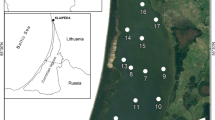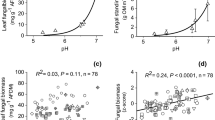Abstract
Community respiration in hyporheic sediments (HCR) was studied in a characteristic riffle-pool-sequence of a mountain stream. HCR activity at the riffle site strongly exceeded that at the corresponding pool site with a mean ratio of 5.3. The vertical distribution of HCR activity was homogeneous in the pool, while there was a distinct maximum in the uppermost layer in the riffle. Similarly, the spatial distribution of certain fractions of particulate organic matter (POM), and their turnover, was largely determined by stream morphology. Mean annual HCR per unit area of stream bed was estimated as 1.71 g O2 m−2 d−1. Hence, HCR contributes significantly to total heterotrophic activity in streams, thus enhancing the relative importance of heterotrophic processes in running waters containing hyporheic zones.
Similar content being viewed by others
References
Bärlocher, F. & J. H. Murdoch, 1989. Hyporheic biofilms — a potential food source for interstitial animals. Hydrobiologia 184: 61–67.
Benner, R., J. Lay, E. K'nees & R. E. Hodson, 1988. Carbon conversion efficiency for bacterial growth on lignocellulose: Implications for detritus-based food-webs. Limnol. Oceanogr. 33: 1514–1526.
Bott, T. L., J. T. Brock, C. E. Cushing, S. V. Gregory, D. King & R. C. Petersen, 1978. A comparison of methods for measuring primary productivity and community respiration in streams. Hydrobiologia 60: 3–12.
Bott, T. L., J. T. Brock, C. S. Dunn, R. J. Naiman, R. W. Ovink & R. C. Petersen, 1985. Benthic community respiration in four temperate stream systems: An inter-biome comparison, and evaluation of the river continuum concept. Hydrobiologia 123: 3–45.
Bott, T. L. & L. A. Kaplan, 1985. Bacterial biomass, metabolic state, and activity in stream sediments: relation to environmental variables and multiple assay comparisons. Appl. Envir. Microbiol. 50:.508–522.
Cahill, R. A. & A. D. Autrey, 1987. Improved measurement of the organic carbon content of various river components. J. Freshwat. Ecology 4: 219–222.
Cummins, K. W., J. R. Sedell, F. J. Swanson, G. W. Minshall, S. G. Fisher, C.E. Cushing, R. C. Petersen & R. L. Vannote, 1983. Organic matter budgets for stream ecosystems: problems in their evaluation. In J. R. Barnes & G. W. Minshall (eds), Stream ecology. Application and testing of general ecological theory. Plenum: 299–353.
Decho, A. W. & D. J. W. Moriarty, 1990. Bacterial exopolymer utilization by a harpacticoid copepod: a methodology, and results. Limnol. Oceanogr. 35: 1039–1049.
Eisma, D., 1993. Suspended matter in the aquatic environment. Springer.
Fiebig, D. M. & M. A. Lock, 1991. Immobilization of dissolved organic matter from groundwater discharging through the stream bed. Freshwat. Biol. 26: 45–55.
Fisher, S. G., 1977. Organic matter processing by a stream-segment ecosystem: Fort River, Massachusetts, U.S.A. Intern. Revue ges. Hydrobiologia 62: 701–727.
Grimm, N. B. & S. G. Fisher, 1984. Exchange between interstitial, and surface water: implications for stream metabolism, and nutrient cycling. Hydrobiologia 111: 219–228.
Hedin, L. O., 1990. Factors controlling sediment community respiration in woodland stream ecosystems. Oikos 57: 94–105.
Hendricks, S. P., 1993. Microbial ecology of the hyporheic zone: a perspective integrating hydrology and biology. J. N. Am. Benthol. Soc. 12: 70–78.
Hynes, H. B. N., 1983. Groundwater, and stream ecology. Hydrobiologia 100: 93–99.
Kaplan, L. A. & T. L. Bout, 1989. Diel fluctuations in bacterial activity on stream bed substrata during vernal algal blooms: Effects of temperature, water chemistry, and habitat. Limnol. Oceanogr. 34: 718–733.
Lampert, W., 1971. The measurement of respiration. In J. A. Downing & F. H. Rigler (ed.), A manual on methods for the assessment of secondary productivity in fresh waters. IBP Hdbk 17, Blackwell: 413–468.
Leichtfried, M., 1988. Bacterial substrates in gravel beds of a second order alpine stream (Project Ritrodat-Lunz, Austria). Verh. int. Ver. Limnol. 23: 1325–1332.
Meyer, E., J. Schwoerbel & G. C. Tillmans, 1990. Physikalische, chemische und hydrographische Untersuchungen eines Mittelgebirgsbaches: Ein Beitrag zur Typisierung kleiner Fließgewässer. Aquat. Sci. 52: 236–255.
Meyer, E. & J. Schwoerbel, 1991. Stoffhaushalt und Stoffumsetzungen in einem kleinen Mittelgebirgsbach des südlichen Schwarzwaldes. Unpubl. final report of DFG project Az. Schw. 63/27-1, 2, 3.
Metzler, G. M. & L. A. Smock, 1990. Storage and dynamics of subsurface detritus in a sand-bottomed stream. Can. J. Fish. aquat. Sci. 47: 588–594.
Middelboe, M., B. Nielsen & M. Sondergaard, 1992. Bacterial utilization of dissolved organic carbon (DOC) in coastal waters. Determination of growth yield. Arch. Hydrobiol. Beih. Ergebn. Limnol. 37: 51–61.
Minshall, G. W., R. C. Petersen, K. W. Cummins, T. L. Bott, J. R. Sedell, C. E. Cushing & R. L. Vannote, 1983. Interbiome comparison of stream ecosystem dynamics. Ecol. Monogr. 53: 1–25.
Naiman, R. J., J. M. Melillo, M. A. Lock, T. E. Ford & S. R. Reice, 1987. Longitudinal patterns of ecosystem processes, and community structure in a subarctic river continuum. Ecology 68: 1139–1156.
Paul, B. J., K. E. Corning & H. C. Duthie, 1989. An evaluation of the metabolism of sestonic, and epilithic communities in running waters using an improved chamber technique. Freshwat. Biol. 21: 207–215.
Pusch, M., 1993. Heterotropher Stoffumsatz und faunistische Besiedlung des hyporheischen Interstitials eines Mittelgebirgsbaches (Steina, Schwarzwald). Ph. D. Thesis Univ. Freiburg/Br.
Pusch, M., 1995. Community respiration in the hyporheic zones of riffles, and pools. In J. Gibert (ed.), Groundwater and surface water ecotones, Cambridge Univ. Press, in press.
Pusch, M. & J. Schwoerbel, 1994. Community respiration in hyporheic sediments of a mountain stream (Steina, Black Forest). Arch. Hydrobiol. 130: 35–52.
Pusch, M. H. E., M. Pusch & U. Braukmann, 1991. Restoration of channelized streams — a benthological study. Verh. int. Ver. Limnol. 24: 1851–1855.
Rausch, T., 1981. The estimation of micro-algal protein content and its meaning to the evaluation of algal biomass. I. Comparison of methods for extracting protein. Hydrobiologia 78: 237–251.
Rounick, J. S. & M. J. Winterbourn, 1983. The formation, structure and utilization of stone surface organic layers in two New Zealand streams. Freshwat. Biol. 13: 57–72.
Rutherford, J. E. & H. B. N. Hynes, 1987. Dissolved organic carbon in streams, and groundwater. Hydrobiolgia 154: 33–48.
SAS Inst., 1987. SAS/STAT guide for personal computers, version 6 edition. Cary, NC, USA.
Schwoerbel, J., 1961. Über die Lebensbedingungen und die Besiedlung des hyporheischen Lebensmums. Arch. Hydrobiol. Supp. 25: 182–214.
Stock, M. S. & A. K. Ward, 1989. Establishment of a bedrock epilithic community in a small stream: Microbial (algal and bacterial) metabolism and physical structure. Can. J. Fish. aquat. Sci. 46: 1874–1883.
Triska, F. J., V. C. Kennedy, R. J. Avanzino, G. W. Zellweger & K. E. Bencala, 1989. Retention, and transport of nutrients in a third-order stream in northwestern California: hyporheic processes. Ecology 70: 1893–1905.
Vannote, R. L., G. W. Minshall, K. W. Cummins, J. R. Sedell & C. E. Cushing, 1980. The river continuum concept. Can. J. Fish. aquat. Sci. 37: 130–137.
White, D. S., C. H. Elzinga & S. P. Hendricks, 1987. Temperature patterns within the hyporheic zone of a northern Michigan River. J. North Am. Benthol. Soc. 6: 85–91.
Williams, D. D., 1993. Nutrient and flow dynamics at the hyporheic/groundwater interface and their effects on the interstitial fauna. Hydrobiologia 251: 185–198.
Winterbourn, M. J., 1986. Recent advances in our understanding of stream ecosystems. In N. Polunin (ed.), Ecosystem theory and application. Wiley: 240–268.
Winterboum, M. J. & C. R. Townsend, 1991. Streams and rivers: One-way flow systems. In R. S. K. Barnes & K. H. Mann (eds), Fundamentals of aquatic ecology, 2nd edn. Blackwell: 230–244.
Author information
Authors and Affiliations
Rights and permissions
About this article
Cite this article
Pusch, M. The metabolism of organic matter in the hyporheic zone of a mountain stream, and its spatial distribution. Hydrobiologia 323, 107–118 (1996). https://doi.org/10.1007/BF00017588
Received:
Revised:
Accepted:
Issue Date:
DOI: https://doi.org/10.1007/BF00017588




